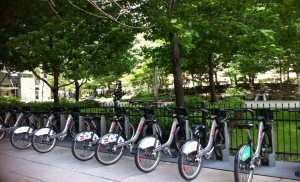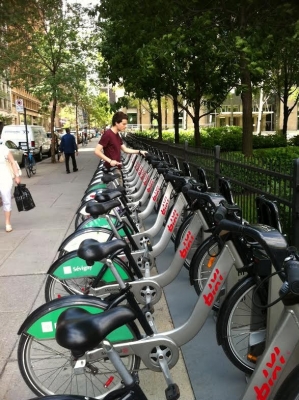

 Homes and neighborhoods are generally more attractive when they are located close to transport links. Is this also the case for bike sharing schemes? In new research which uses Montreal’s Bixi scheme as a case study, Ahmed El-Geneidy, Dea van Lierop, & Rania Wasfi examine the influence of bike sharing stations on the attractiveness of nearby housing. They find that a home which has 12 stations within 800 meters can be expected to sell for nearly 3 percent more compared to those which have no nearby bike sharing stations. They also find that bike sharing stations give municipalities the opportunity to profit from higher property taxes.
Homes and neighborhoods are generally more attractive when they are located close to transport links. Is this also the case for bike sharing schemes? In new research which uses Montreal’s Bixi scheme as a case study, Ahmed El-Geneidy, Dea van Lierop, & Rania Wasfi examine the influence of bike sharing stations on the attractiveness of nearby housing. They find that a home which has 12 stations within 800 meters can be expected to sell for nearly 3 percent more compared to those which have no nearby bike sharing stations. They also find that bike sharing stations give municipalities the opportunity to profit from higher property taxes.
The decision to rent or buy a home is one that most adults go through several times in their life. It is a choice that is bounded by complex preferences and restrictions. Restrictions can be related to the affordability to reside in certain units or to the space needed due to family size. Preferences can be related to the amenities available in the home or in the neighborhood where it is located. Some people might pay more for certain amenities either in the home or in the neighborhood, or they might pay less due to the presence of a problem or source of discomfort nearby. Research has shown that access to different transport alternatives around a home is considered to be an influential factor in determining housing prices. Individuals do pay a premium to have access to a variety of transport options, especially transport services that provides a better access to opportunities in a region. For example being near a new high quality light rail station is expected to have a positive impact on home and land values even right after the announcement of station location and prior to the construction.

Several cities around the world are currently investing in active transport facilities due to the well-known benefits of these facilities to the society, such as environmental and health benefits. Such facilities include, for example, off-street facilities for bicycle and pedestrian use, a bicycle lane along an existing street, and providing a bicycle sharing system. Bicycle sharing systems has been growing rapidly in the past decade; as of December 2015 there were around 980 cities around the world with active bicycle sharing systems. The new generation of bicycle sharing systems depends on the presence of docking station where individuals can check out a bicycle and return it to any other station in the bicycle sharing service area, even some new systems allow users to leave the bicycle at any place within the service area provided paying an extra fees. Similar to any transport facilities bicycle sharing systems are used by a range of individuals and cities are promoting their use due to the positive impacts of these systems on the overall society. Financially many of these systems have faced big challenges, which led to reporting financial loss and bankruptcy in some cases. Despite the financial difficulties sustaining the bicycle sharing programs, some local governments see them as a non-profit public service. Accordingly, in their opinion keeping these bicycle sharing systems running is important for the society due to its overall direct and indirect benefits.
Bicycle sharing systems provide users with a sustainable mode of access to opportunities in a region; accordingly it is expected to have an impact on home values in areas where they are operating. Quantifying these impacts in regions where these systems are running can give better insights for policy makers of some of the indirect benefits that can be derived from bicycle sharing systems.

Our recent study based in Montreal Canada has looked at the relation between the bicycle sharing system operating in Montreal (Bixi) and home sale prices. Our study used multiple sales for units in multifamily housing that were reported in the Multiple Listings Service (MLS) of Montreal between 1996 and 2012. To control for changes in the housing market, we used sales conducted in neighbourhoods where bicycle sharing does and does not operate. Using only repeated sales gave the opportunity to control for many of the variations in housing prices. This meant we were able to estimate the impacts of bicycle sharing systems on sale prices of units in multifamily housing.
Our analyses found a statistically significant impact of the presence of bicycle sharing systems on sale values of units in multifamily housing; on average, a home that has 12 stations within its vicinity (800 meters) is expected to sell at a value of 2.7 percent more when compared to the same unit with no bicycle sharing stations nearby. Accordingly bicycle sharing coverage will not only benefit the residents locating in these areas, but also act as an opportunity for municipalities to profit from higher property taxes.
Like many changes in urban form, increasing the availability of bicycle share stations will have benefits both nearby and further away. The immediate economic benefits stem from increases in municipal property taxes. However, it must be acknowledged that increasing the coverage of a bicycle sharing system or the number of station in an area will come at a cost. Cities that are considering the implementation or expansion of bicycle share systems must recognize that although seed capital can be high, increases in property taxes near bicycle sharing facilities might out weight the initial costs.
This article is based on the paper, ‘Do people value bicycle sharing? A multilevel longitudinal analysis capturing the impact of bicycle sharing on residential sales in Montreal, Canada’, in Transport Policy.
Featured image credit: Shawn Carpenter (Flickr, CC-BY-SA-2.0)
Please read our comments policy before commenting.
Note: This article gives the views of the author, and not the position of USAPP – American Politics and Policy, nor the London School of Economics.
Shortened URL for this post: http://bit.ly/2buFDLa
_________________________________
 Ahmed El-Geneidy – McGill University
Ahmed El-Geneidy – McGill University
Ahmed El-Geneidy is an Associate Professor at the school of Urban Planning, McGill University. His research interest includes land sue and transport interaction, planning for active transport and public transport planning and operations.
 Dea van Lierop – McGill University
Dea van Lierop – McGill University
Dea van Lierop, is a PhD candidate at the school of Urban Planning, McGill University. Her research interest including survey design for active modes of transport, and public transit marketing and operations.
 Rania Wasfi – University of Montreal
Rania Wasfi – University of Montreal
Rania Wasfi is a post-doctoral research fellow at CRCHUM at the University of Montreal. Her research interest include planning for active transport, and the impacts of the built environment on behavior and health of adults and seniors.




1 Comments